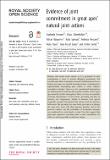Files in this item
Evidence of joint commitment in great apes’ natural joint actions
Item metadata
| dc.contributor.author | Heesen, Raphaela | |
| dc.contributor.author | Zuberbühler, Klaus | |
| dc.contributor.author | Bangerter, Adrian | |
| dc.contributor.author | Iglesias, Katia | |
| dc.contributor.author | Rossano, Federico | |
| dc.contributor.author | Pajot, Aude | |
| dc.contributor.author | Guéry, Jean-Pascal | |
| dc.contributor.author | Genty, Emilie | |
| dc.date.accessioned | 2021-12-15T13:30:04Z | |
| dc.date.available | 2021-12-15T13:30:04Z | |
| dc.date.issued | 2021-12-08 | |
| dc.identifier | 276763806 | |
| dc.identifier | 39516545-157a-4981-8c6f-2d7d64a51541 | |
| dc.identifier | 000727798900002 | |
| dc.identifier | 000727798900002 | |
| dc.identifier.citation | Heesen , R , Zuberbühler , K , Bangerter , A , Iglesias , K , Rossano , F , Pajot , A , Guéry , J-P & Genty , E 2021 , ' Evidence of joint commitment in great apes’ natural joint actions ' , Royal Society Open Science , vol. 8 , no. 12 , 211121 . https://doi.org/10.1098/rsos.211121 | en |
| dc.identifier.issn | 2054-5703 | |
| dc.identifier.other | ORCID: /0000-0001-8378-088X/work/105318161 | |
| dc.identifier.uri | https://hdl.handle.net/10023/24514 | |
| dc.description | The present research was supported by the Swiss National Science Foundation (Grant No. awarded to AB and KZ). | en |
| dc.description.abstract | Human joint action seems special, as it is grounded in joint commitment - a sense of mutual obligation participants feel towards each other. Comparative research with humans and nonhuman great apes has typically investigated joint commitment by experimentally interrupting joint actions to study subjects’ resumption strategies. However, such experimental interruptions are human-induced, and thus the question remains of how great apes naturally handle interruptions. Here, we focus on naturally-occurring interruptions of joint actions, grooming and play, in bonobos and chimpanzees. Similar to humans, both species frequently resumed interrupted joint actions (and the previous behaviours, like grooming the same body part region or playing the same play type) with their previous partners and at the previous location. Yet, the probability of resumption attempts were unaffected by social bonds or rank. Our data suggests that great apes experience something akin to joint commitment, for which we discuss possible evolutionary origins. | |
| dc.format.extent | 15 | |
| dc.format.extent | 618563 | |
| dc.language.iso | eng | |
| dc.relation.ispartof | Royal Society Open Science | en |
| dc.subject | joint action | en |
| dc.subject | joint commitment | en |
| dc.subject | great apes | en |
| dc.subject | social grooming | en |
| dc.subject | social play | en |
| dc.subject | politeness theory | en |
| dc.subject | BONOBOS PAN-PANISCUS | en |
| dc.subject | WILD CHIMPANZEES | en |
| dc.subject | NATIONAL-PARK | en |
| dc.subject | HIERARCHIES | en |
| dc.subject | VALIDATION | en |
| dc.subject | EVOLUTION | en |
| dc.subject | BF Psychology | en |
| dc.subject | DAS | en |
| dc.subject.lcc | BF | en |
| dc.title | Evidence of joint commitment in great apes’ natural joint actions | en |
| dc.type | Journal article | en |
| dc.contributor.institution | University of St Andrews. Institute of Behavioural and Neural Sciences | en |
| dc.contributor.institution | University of St Andrews. Centre for Social Learning & Cognitive Evolution | en |
| dc.contributor.institution | University of St Andrews. School of Psychology and Neuroscience | en |
| dc.identifier.doi | https://doi.org/10.1098/rsos.211121 | |
| dc.description.status | Peer reviewed | en |
This item appears in the following Collection(s)
Items in the St Andrews Research Repository are protected by copyright, with all rights reserved, unless otherwise indicated.

